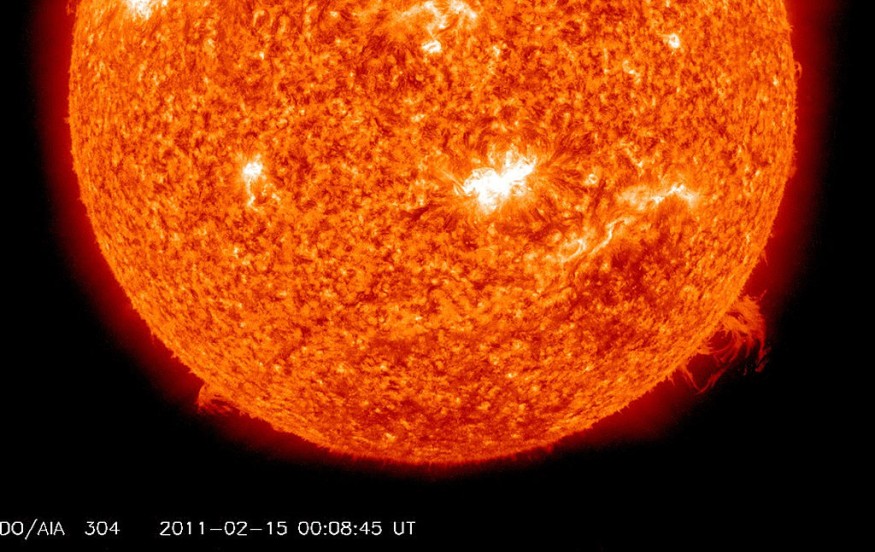Over the weekend, Earth saw a solar storm temporarily disrupting the planet's magnetosphere.
According to The Express, the storm was brought on by an unanticipated Coronal Mass Ejection (CME) and solar wind.
When the sun expels electromagnetic fluctuations and a cloud of charged particles from its atmosphere, it results in CME.
They are among the strongest kind of solar storms.

Geomagnetic Storm Surprisingly Erupts, Forecasters Baffled
Experts from Spaceweather.com (via Newsbreezer) noticed a small G1 class geomagnetic storm erupted around midnight (UT) between June 25 and 26.
Forecasters don't know the cause but believe that an unanticipated CME embedded in the solar wind was behind the phenomenon.
The six-hour storm has not yet been associated with any aurora sightings.
The solar storm, given the G1 classification, only had a small impact on satellite communications and modest power grid oscillations.
"Fast solar wind hits Earth!" Dr. Tamitha Skov, a space weather researcher, stated on Twitter Saturday.
Skov warned that there might be stormy weather for the next 48 to 72 hours.
She added that mid-latitude viewers might occasionally see the aurora. However, the high latitude chasers should see strong displays.
Throughout the Field Day weekend, Skov said amateur radio operators keep an eye out for minor interruptions and auroral propagation.
Fast solar wind hits Earth! Expect unsettled to stormy conditions for the next 48-72 hrs. High latitude #aurora chasers should get good shows with sporadic views at mid-latitudes. Amateur radio operators watch for minor disruptions & auroral propagation through #FieldDay weekend. pic.twitter.com/WqSGwv5eMA
— Dr. Tamitha Skov (@TamithaSkov) June 25, 2022
About Solar Storms
The aurora borealis and australis are enhanced when a CME is directed toward the Earth.
These purely natural light displays are caused by solar wind particles exciting higher atmosphere atoms, which causes them to glow.
The resulting wavy patterns frequently resemble light curtains, typically in shades of pink and green, like the Northern Lights.
Solar flares are yet another kind of solar storm. According to NASA, a solar flare is a strong flash of radiation or light on the sun.
Solar flares are a sudden explosion of energy caused by tangling, crossing, or reorganizing magnetic field lines near sunspots.
On June 20, last week, a sizable sunspot was found and it doubled in size in just 24 hours, according to SpaceWeather.com. A solar flare's tremendous heat cannot reach our planet's surface unlike electromagnetic radiation and energetic particles.
When a GPS satellite, for example, transmits a signal to Earth, there may be temporary interruptions in the high atmosphere that cause the signal to be off by many yards.
Solar Cycle
Solar storm frequency fluctuates greatly during the course of our sun's 11-year cycles, from many per day during solar maximum to fewer than one per week during solar minimum. The sun is currently rising up because the most recent solar low occurred in December 2019.
Newsweek said the sun is currently in Solar Cycle 25, which is doing better than expected. According to the National Oceanic and Atmospheric Administration's (NOAA) most recent advancement chart, the sun is far ahead of schedule to achieve the solar maximum. The number of sunspots in May was the greatest in almost eight years, according to spaceweather.com.
The risk presented to Earth at the solar maximum may grow due to increased solar storm frequency. Plasma or high-energy electromagnetic radiation is rarely directed directly at the Earth by CMEs.
The Northern and Southern Lights, also known as aurorae, result from low-level solar particles striking the Earth's magnetosphere, a layer of the planet's magnetic field. The electricity grid, however, may conceivably be destroyed by a higher-energy solar emission burst that is focused directly on the Earth.
RELATED ARTICLE : Massive Sunspot Doubles in Size in 24 Hours and Could Send Giant Solar Flare Toward the Earth Affecting Mobile Phones, Satellites and Power Grids
Check out more news and information on Space in Science Times.
© 2025 ScienceTimes.com All rights reserved. Do not reproduce without permission. The window to the world of Science Times.











